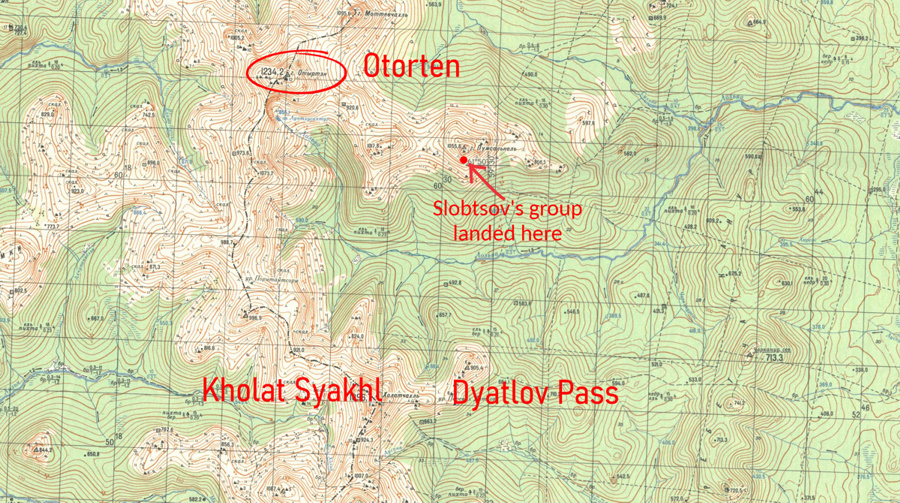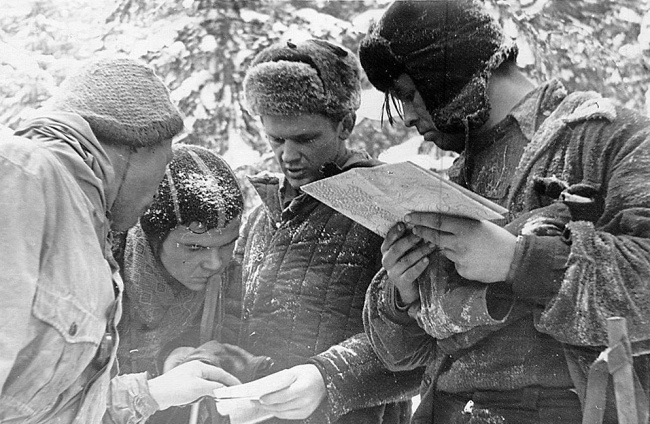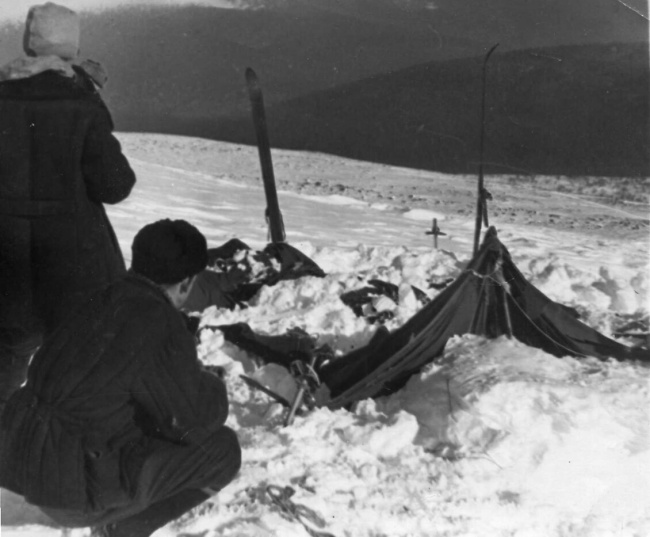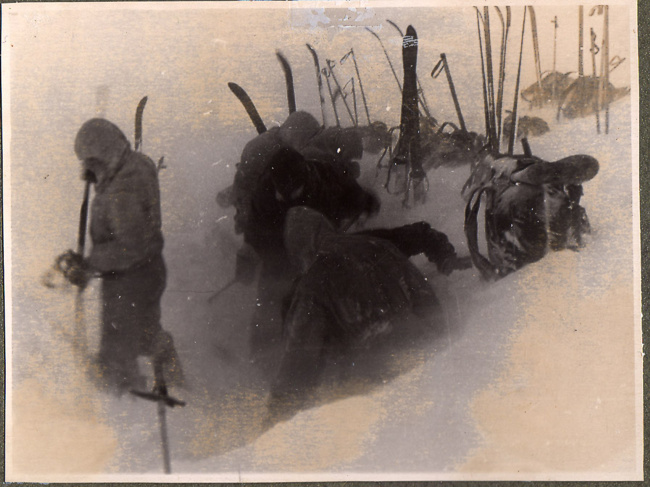
The search for the Dyatlov group
A summary of the conversation between Vladimir Borzenkov and Evgeniy Buyanov with Boris Slobtsov on September 22, 2006
(The text was checked by Borzenkov and Slobtsov to avoid errors and inaccuracies)

Slobtsov's group landed here by mistake due to low visibility
Upon returning to Sverdlovsk, the "tenth" member of the Dyatlov group, Yuri Yudin, came to the sports club of the institute (UPI) and reported that Igor Dyatlov had asked to postpone the deadline for the group's return by 2 days (from February 10 to 12).
This partially explains the delay in the search teams' reaction. Some time was spent "warming up", they thought that the group had simply been delayed on the route. Around February 15, the alarm was raised, and everything "got going". Having learned that the Dyatlov group had not arrived on time, Slobtsov and Vadim Brusnitsyn came to the sports club and expressed their readiness to participate in the search operations. Slobtsov was offered to lead the group. In Ivdel, a local hunter and a radio operator with a walkie-talkie were added to Slobtsov's group, and in total it included 9 people.
Of course, even after the groups were assembled, it took time to prepare and transfer them. Preparation included clarifying their route and search tactics. The following tactics were chosen. Search groups were dropped off by helicopter at different points along the route of the Dyatlov group.
Then these groups, split into smaller reconnaissance groups of 2-3 people, searched for traces in radial directions without carrying anything. Then the entire group was transferred by helicopter or moved along the route to a more remote point, set up a new bivouac, and again searched in radial directions. And so on. After gathering, Slobtsov's group flew to the Ivdel airfield on AN-2 planes, spent the night there, and was then transferred to the search area by helicopter. This is how the groups' "maneuvers" looked at first. As a result of these actions, what happened was what was written about later: three groups crossed Dyatlov's route in search of tracks, and Slobtsov's group managed to find vague tracks and follow Dyatlov's route in their own search area.
Slobtsov's group was the "rookiest", the youngest, and with the least hiking experience. In particular, in these indicators, it was noticeably inferior to Dyatlov's group (on average, by 2 years). This group initially turned out to be the northernmost search party - it was supposed to be dropped near Mount Otorten
The helicopter navigator made a mistake, dropped the group significantly further south, and it took them another 2-3 days to approach Mt Kholat Syakhyl, to the pass near which the tent was found. Before the discovery of the tent, the group had spent at least two nights in different places; the group was walking through the taiga, and its first exit up the ridge to the pass above the forest line led to the discovery of the Dyatlov group's tent.

Search engines at work: In the center is Slobtsov, on the left (shoulder): Sharavin, on the right is Halizov (Slobtsov does not remember the last name of the second participant from the left).
During reconnaissance towards the pass (later - Dyatlov Pass) they planned to see Mt Otorten and the approaches to it. There was a suspicion that Dyatlov's group could have fallen from the ledge, as hunters and reindeer herders fell from it according to local legends. They wanted to see and study these ledges. The reconnaissance group included Boris Slobtsov, Mihail Sharavin and a local hunter. After reaching the ridge of the pass, Sharavin noticed a suspicious dark object on the slope. The local hunter did not want to go further, citing poor health - apparently, he sensed "something bad". Slobtsov and Sharavin went on together. The crust was hard, they climbed on skis, and there was practically no fresh snow. A layer of fresh snow lay lower under the mountain approximately at the border of the forest, but this was noted later. It was possible to walk on the crust in boots - when they dug out the tent they took off their skis.
- 2 -
They approached the tent from the entrance, a little from below and from the side. There was one pole by the tent, and the second (the further one, at Otorten's side) pole had fallen over.

Excavation of the tent. The investigation team is at the tent. The photo was taken later, not at the moment the tent was discovered.
The fabric of the tent was visible from both poles, and the tent was covered with snow in the middle. They did not pay attention to the tracks near the tent. The tracks on the hard snow crust were very faint, they required a careful examination. The excavation of the tent was carried out carefully with ski poles and an ice axe found near the tent. Slobtsov does not remember exactly where the ice axe was found, most likely, it was stuck in the snow at the entrance to the tent or one of the guy ropes from the entrance was attached to it.
First of all, it was necessary to make sure that there was no one in the tent, no bodies, no people, that it was abandoned. From the entrance, they found a jacket hanging inside the tent, with a rectangular tin box from Montpensier fruit drops in the pocket. The box contained Igor Dyatlov's documents, the group's return train tickets, money, and the Dyatlov group's route book.
From the middle of the tent, they retrieved a flask of alcohol and another thing (Slobtsov doesn't remember exactly what it was - it seems it was a camera).
They decided to take these three things as material evidence of the discovery of Dyatlov's tent. Having made sure that there was no one in the tent, Slobtsov and Sharavin walked away from the tent, put on their skis and quickly went down to their camp in the Auspiya Valley, making it before dark and before the evening radio to report the find.
In the evening, during dinner, they poured some alcohol into mugs and raised a toast to the health of their comrades, the members of Dyatlov's group. To which the local hunter gloomily objected that they should drink "for the repose of the soul"... He was almost beaten - even now, when the abandoned tent was discovered, the guys still did not admit the thought that the Dyatlov group had died. But the hunter had already realized that "things were bad"... The next day, Slobtsov and Sharavin left the camp a few hours later than the rest of the group - by the time they arrived, the bodies of Doroshenko and Krivonischenko had already been discovered... Slobtsov did not witness the discovery of the other three Dyatlov group members, who were found a little later (Dyatlov, Slobodin, Kolmogorova). Slobtsov did not examine the tracks below the tent - he saw the Dyatlov group's tracks in the forest in the form of dents, heavily covered with snow.
Rescue forces were quickly pulled into the Auspiya Valley - a large army tent with a stove was set up here, heavy army sleeping bags and food were brought in. Several soldiers guarded the tent, chopped firewood and cooked food. Hikers and climbers took part in the search. Detectives with service dogs, sappers with mine detectors, and members of the investigative team (including correspondent Yuri Yarovoy) arrived.
Almost all the search capabilities that the regional authorities had were used. Colonel Ortyukov arrived and was there almost constantly, leading the search. The student hikers nicknamed him "Otorten".
The search continued, and each time the searchers approached the search area from the camp in the Auspiya Valley along a beaten path (ski track), and returned back along it to the camp for the night. It was forbidden to go any other way, so as not to confuse the tracks and not to get lost.
Mine detectors were used to search for a knife, since cuts were found on the branches near the fire.
After finding five dead people, they were lifted to the pass for evacuation by helicopters.
On the day they were lifted, the wind from the pass reached hurricane force, so the lift required considerable effort. The helicopter arrived later, landed on the pass and took the dead from the rescuers (Slobtsov does not remember whether he participated in loading the dead, but he did participate in transporting them to the pass).
- 3 -
After studying the diaries of the Dyatlov group found in the tent, Slobtsov and his group members were ordered to find the Dyatlov group's labaz, which they learned about from the diaries. The labaz was found fairly quickly, within 24 hours. Since the reasons for the death of the Dyatlov group were unclear, the search leadership took additional security measures to protect the search group so that the story with the Dyatlov group's tent would not repeat itself with the rescuers' tent. The soldiers were armed, and a guard was on duty at night near the tent. The possibility of an attack by wild animals or criminals was not ruled out. But the student hikers were somewhat ironic about these measures: "Who would wander into such a wilderness"... True, during a helicopter flight over the search area, two escaped prisoners thieves were noticed and caught. They thought that the search is for them and immediately raised their hands up. But this happened much closer to the village, far from Mount Kholat Syakhl. Of course, they were thoroughly searched, but no Dyatlov group belongings or firearms were found on them...
Then the search dragged on for a long time, and continued without results until the remaining four bodies were found. After the group of climbers arrived to replace them, Slobtsov, Sharavin and Brusnitsyn were summoned to the prosecutor's office to give testimony: Slobtsov three times, and Brusnitsyn twice. They were asked again and again to write down in detail what they observed, so as not to miss details and verify the testimony. At one point, the investigator left the office, and Slobtsov and Brusnitsyn, driven by childish curiosity, leafed through the file lying on the table. In the file, they remembered "something like" Maslennikov's "non-disclosure". Slobtsov and Brusnitsyn were not asked to sign a non-disclosure. But Maslennikov, a master of sports in tourism, was the head of the search, and also the party chief at the Verh-Isetsky Steel Plant. He knew a little more than the ordinary rescuers and group leaders.
When the search dragged on, became boring, and the rescuers were very tired (in all respects), the "people" began to look for all sorts of entertainment, forms of "brightening up" their leisure time... They couldn't do without bringing in "drinks"...
Experienced rescuers and hikers who arrived from Moscow and the Elbrus region recommended stopping them for a while until the snow melted. No! A decree was issued not to stop the search, the order: "Find everyone!" It is possible that the order came from the "very top". There was a rumor among the rescuers that the order came directly from Khrushchev himself.
These four guys were not immediately recognized even by their relatives - the process of tissue destruction had begun. Even Yuri Doroshenko (who was found among the first) was not recognized at first by his mother (of course, it is very difficult for a mother to believe in her son's death). A girl she knew recognized him, and then his mother...
Lyuda Dubinina's father told his relatives not to go to identify him - the sight and memory of him was too difficult... The four were buried in closed coffins - this is always done when there are signs of decomposition.
Among the rescuers, there were many different opinions and conversations about the emergency situation and the causes of the Dyatlov group's accident. Boris Slobtsov did not observe any unusual natural phenomena during the search, and he does not believe in any supernatural tales. In his opinion, the accident occurred due to natural causes that are not yet completely clear. Slobtsov does not know of any facts about the KGB's involvement in the investigation of the Dyatlov group accident.
An opinion prevailed among the searchers that the Dyatlov group was forced to stop at the place where the accident occurred. Someting natural like a fog, heavy snow, and the wind had begun to pick up. Visibility had dropped sharply. The group had passed the pass, but perhaps had not even noticed it, and had continued moving, moving away from the wind to the leeward slope of the mountain. In conditions of poor visibility, Dyatlov decided to stop: it was easy to get lost in the snowstorm, and he did not want to go back either. The daylight was coming to an end... Perhaps, in conditions of poor visibility, they were unable to get a good view of the slope above and below the place where the tent was set up.

The last photo of the Dyatlov group
We looked at the last photo of the Dyatlov group. According to Slobtsov, the snow cover in the photo is significantly different - not the same as when the tent was found. There is no complete certainty that the photo was taken at the accident site. I it could have been taken earlier, at previous breaks... But still, it was the last photo, and it does not look like it was taken in the forest...
We presented our versions of events to Slobtsov. I, Buyanov, my "long" version with an avalanche as a stage, and Borzenkov, in an earlier conversation, his infrasound. We laid down our arguments. Boris Efimovich listened to both versions, expressed his comments and doubts. He has not yet resolutely denied or accepted any theory. His assessments were extremely cautious and reserved. Taking into account his information, I decided to adjust the previously constructed monitoring of events according to the "long" version of the accident.
- 4 -
Slobtsov spoke a little about the hikes and training of mountaineers in those years. Specialization and training then were noticeably different from today. Characteristically, UPI hikers then went on ski, mountain, and water hikes, and prepared for each such hike according to its specifics. For example, for water hikes they learned to cut rafts. Thus, the 1958 hike in the Sayan Mountains was a pedestrian and water hike: hikers went up the river, built rafts and went downstream. Slobtsov took part in this hike together with Brusnitsyn, Halizov, Dubinina, Kolmogorova and Doroshenko. They witnessed the death of a hiker (a student from MIPT) from another group in a rapid (Bazybaisky rapids on the Kazyr River, Central Sayan - Borzenkov has a photo of a monument to this dead hiker on Bazybai...). During this expedition, Lyuda Dubinina was wounded in the leg by a pellet due to careless handling of a weapon. Before that, many of the Dyatlov group had taken part in a mountain hike in the Caucasus, approximately at the level of a modern mountain 2nd category of difficulty. So the range of hikes was wide, but the special training in types of mountaineering was not deep enough by modern standards. Slobtsov, in particular, does not remember any special training of the Dyatlov group in falls on the slope on skis. In the summer of 1959, the accident area was closed to visitors, although many hikers - close friends of the Dyatlov group and relatives - were eager to go there. Boris Efimovich decided from that time to take up mountaineering, and never returned to tourism. He was engaged in mountaineering until 1975, became a master of sports, conquered many peaks, including 3 seven-thousanders of the USSR. In the Tien Shan (Chapaev Peak near Khan-Tengri in the Tengri-Tag Range, 1962) he got into a small avalanche and barely survived: the entire group fell and flew down the slope for 800 m, everyone was seriously injured. We omit the "lyrical" digressions in the form of memories of hikes, ascents, regions, avalanches and mutual acquaintances.












